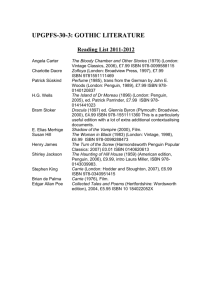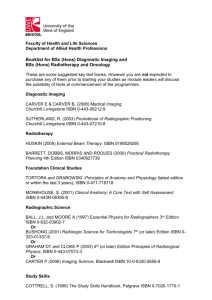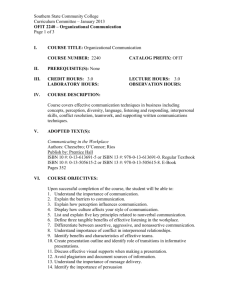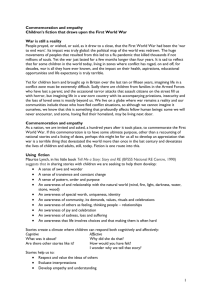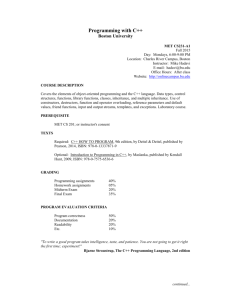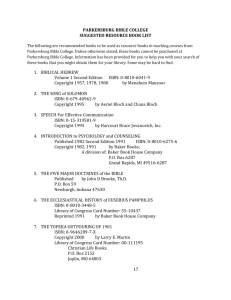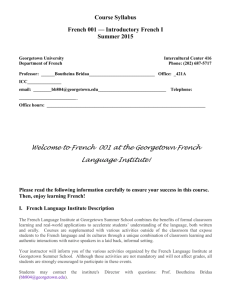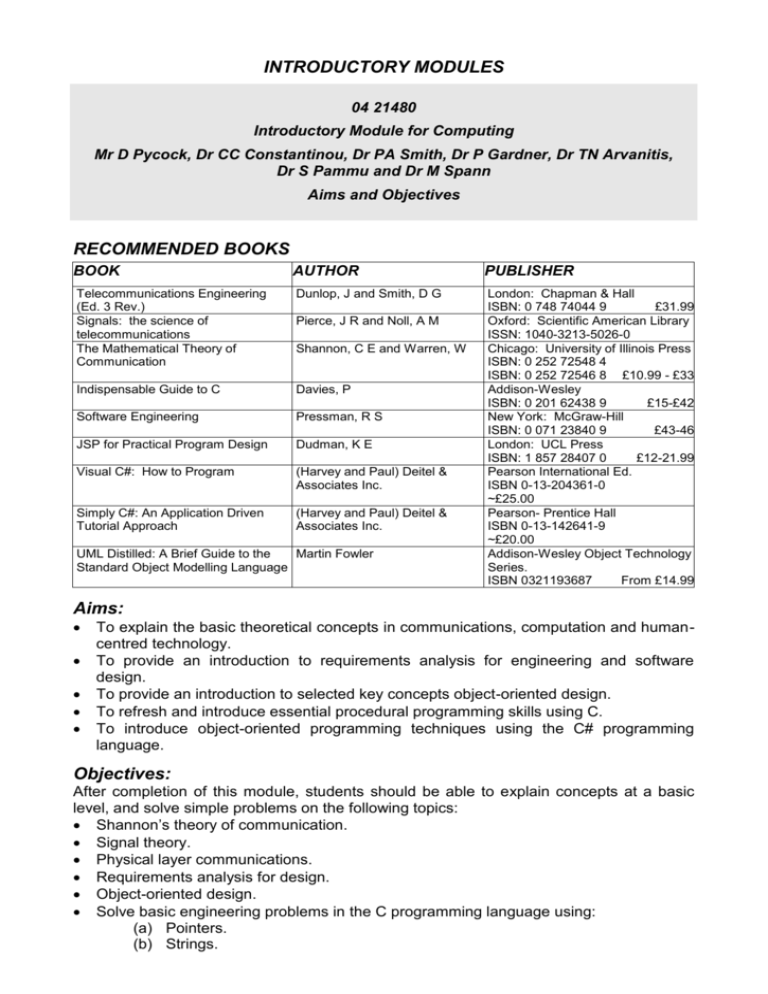
INTRODUCTORY MODULES
04 21480
Introductory Module for Computing
Mr D Pycock, Dr CC Constantinou, Dr PA Smith, Dr P Gardner, Dr TN Arvanitis,
Dr S Pammu and Dr M Spann
Aims and Objectives
RECOMMENDED BOOKS
BOOK
AUTHOR
PUBLISHER
Telecommunications Engineering
(Ed. 3 Rev.)
Signals: the science of
telecommunications
The Mathematical Theory of
Communication
Dunlop, J and Smith, D G
Indispensable Guide to C
Davies, P
Software Engineering
Pressman, R S
JSP for Practical Program Design
Dudman, K E
Visual C#: How to Program
(Harvey and Paul) Deitel &
Associates Inc.
Simply C#: An Application Driven
Tutorial Approach
(Harvey and Paul) Deitel &
Associates Inc.
London: Chapman & Hall
ISBN: 0 748 74044 9
£31.99
Oxford: Scientific American Library
ISSN: 1040-3213-5026-0
Chicago: University of Illinois Press
ISBN: 0 252 72548 4
ISBN: 0 252 72546 8 £10.99 - £33
Addison-Wesley
ISBN: 0 201 62438 9
£15-£42
New York: McGraw-Hill
ISBN: 0 071 23840 9
£43-46
London: UCL Press
ISBN: 1 857 28407 0
£12-21.99
Pearson International Ed.
ISBN 0-13-204361-0
~£25.00
Pearson- Prentice Hall
ISBN 0-13-142641-9
~£20.00
Addison-Wesley Object Technology
Series.
ISBN 0321193687
From £14.99
Pierce, J R and Noll, A M
Shannon, C E and Warren, W
UML Distilled: A Brief Guide to the
Martin Fowler
Standard Object Modelling Language
Aims:
To explain the basic theoretical concepts in communications, computation and humancentred technology.
To provide an introduction to requirements analysis for engineering and software
design.
To provide an introduction to selected key concepts object-oriented design.
To refresh and introduce essential procedural programming skills using C.
To introduce object-oriented programming techniques using the C# programming
language.
Objectives:
After completion of this module, students should be able to explain concepts at a basic
level, and solve simple problems on the following topics:
Shannon’s theory of communication.
Signal theory.
Physical layer communications.
Requirements analysis for design.
Object-oriented design.
Solve basic engineering problems in the C programming language using:
(a) Pointers.
(b) Strings.
(c) Structured data types.
(d) Static and dynamic arrays.
(e) Passing by value and reference.
After completing the second part of this module students will:
Have an overview of the .NET programming framework.
Be familiar with developing programs using Visual Studio.NET
Have a good basic grounding in the C# programming language and its syntax
Have an understanding of the principles of object oriented programming.
Be able to use some of the more advanced features of C# such as graphics
programming, multi-threading, web forms and web services.
To have an overview of the Windows Mobile operating system and be familiar with
program development on mobile devices
Teaching Methods:
PART ONE – INTRODUCTION
28 hours lectures, 3 hours tutorials.
PART TWO – PROGRAMMING
28 x 1 hour lectures, 3 x 1 hour tutorials and 5 x 2 hour practical classes.
There will also be a revision class at the end of term.
Laboratory Work:
These are introductory laboratory and tutorial sessions where students will be shown how
to use the editor and compiler to simple C programs and will learn how to construct
progressively more complex object-oriented programmes using C#.
Private study:
Students are expected to supplement classroom periods and laboratory sessions.
Assignments will be provided to enable you to do this in private study periods.
Assessment:
Written, unseen examination answering 2 questions from 3 in 1.5 hours (30%) and one
assignment report related to object-oriented programming (70%).
Resit
Normally a written unseen examination of 1.5 hours answering 2 questions from 3 (30%)
and a 7 hour laboratory exercise (70%).
Pre-requisites
It is expected that you have some previous knowledge in at least two of the following
topics engineering mathematics, requirements analysis and C programming.
INTRODUCTORY MODULES
04 21480
Introductory Module for Computing
Mr D Pycock, Dr CC Constantinou, Dr PA Smith, Dr P Gardner, Dr TN Arvanitis,
Dr S Pammu and Dr M Spann
Syllabus
Introductory Concepts
(i)
(ii)
(iii)
(iv)
(v)
Shannon's Theory of Communication.
The Description of Signals: Fourier (Bandwidth), Sampling Theorem, Noise.
Interference; Modulation and Encoding.
Physical Communication Media, Switching Devices.
Software design methods for procedural programming, cohesion, coupling.
Procedural Programming (C):
(i)
(ii)
(iii)
(iv)
(v)
Pointers.
Functions, passing by value and by reference.
Static and dynamic arrays.
Strings.
User defined data structures.
Requirements Analysis and Object-Oriented Design Concepts
(i)
(ii)
(iii)
(iv)
(v)
Use-Case Analysis.
Objects and Classes.
Interaction diagrams.
Sequence diagrams.
Sates and statecharts.
Object-Oriented Programming (C#):
(i)
(ii)
(iii)
(iv)
(v)
(vi)
(vii)
(viii)
(ix)
Introducing the .NET framework.
An introduction to C#.
Classes.
Inheritance and polymorphism.
Interfaces, delegate and callback functions.
Graphical user interfaces.
Graphics and multi-media.
Web forms and web controls.
Web services.


